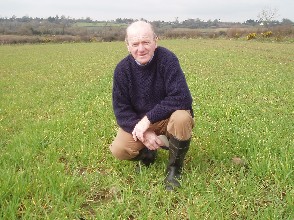 |
 |
 |
 |

|
 |
 |
 |
 |

|
|
Cereal crops across Northern Ireland are starting to grow on following the recent spell of mild weather. Earlier this week Farming Life’s Richard Halleron and Syngenta’s Raymond Hilman got together to inspect a crop of Pearl winter barley sown out last September in good conditions at Broomhedge between Lisburn and Moira. |
 Syngenta's Raymond Hilman |
|
The field in question is a clay loam which had previously been in Spring barley and potatoes. Like many barley crops it had yellowed significantly over recent weeks but was now responding to a dressing of 4 bags to the acre of 20:10:10, applied on Friday March 16 “Many people believe that the yellowing is due solely to a lack of Nitrogen,” Raymond pointed out. “However, in many cases it is caused by water logging of the soil. As a consequence, the plants are deprived the Oxygen which they need to convert the Nitrogen that is available into a form which they can utilise for crop growth. And there’s little doubt that 2006/07 will go down as one of the wettest winters on record.” Raymond also commented that the crop was almost entirely free of grass weeds, a fact he attributed to an application of Syngenta’s new herbicide Defy, prior to emergence. The crop will receive a top dressing of Nitrogen in about three weeks time. With regard to disease protection, Raymond advised a two stage spraying programme: “An immediate application of Kayak, a new liquid formulation containing cyprodinil, will give improved field performance against Rhynchosporium. It will also give broad spectrum disease control against Net Blotch, Mildew and Eye Spot. It will be applied at an application rate is 1 litre per hectare, along with Cherokee, active ingredients chlorothalonil, 62.5 g/l propiconazole and 50 g/l cyproconazole, at a rate of 1.33 litres per hectare. The growth regulator Moddus will also be applied to the tank mix at the rate of 0.2 litres per hectare.” The second spray will be applied just before heading and will contain Amistar Opti at the rate of 1.5 litres plus Menara at 0.4 per hectare. “Amistar Opti contains azoxystrobin and chlorothalonil and will help to control Net Blotch, Brown Rust and Leaf Blotch. “In addition strobilurins have been shown to keep crops greener for longer, thereby helping to maximise yields.
|